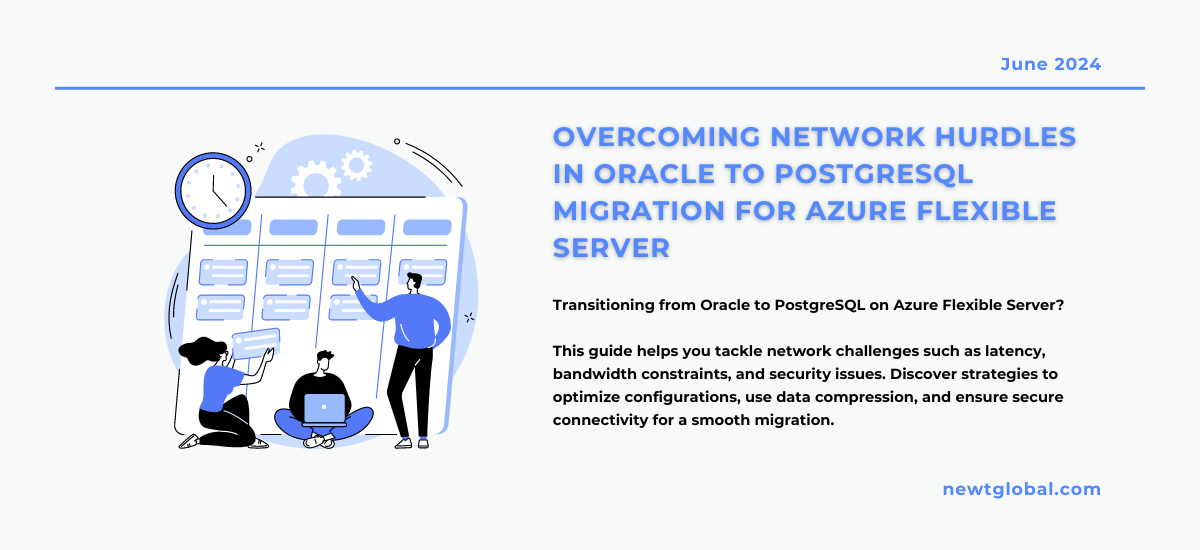
Are you an Oracle user exploring cloud migration options, particularly aiming to overcome network hurdles in the transition to PostgreSQL for Azure Flexible Server deployment? Look no further. This technical guide is tailored for database migration enthusiasts like you, offering insights and strategies to navigate the complexities of migrating from Oracle to PostgreSQL in the cloud.
In the domain of cloud computing, optimizing database infrastructure is paramount for business agility and cost-effectiveness. As an Oracle user, you’re likely aware of the challenges associated with legacy systems and on-premises databases. However, migrating to the cloud opens up a world of opportunities, especially with solutions like PostgreSQL on Azure Flexible Server. But before you embark on this journey, it’s crucial to understand the network hurdles and technical complexities involved in the migration process.
Imagine seamlessly transitioning your Oracle database to PostgreSQL on Azure Flexible Server, unlocking unparalleled scalability, cost-efficiency, and performance in the cloud. By addressing network challenges proactively and leveraging advanced migration strategies, you can achieve this desired outcome with confidence. This blog will equip you with the knowledge and tools necessary to navigate the complexities of database migration and embark on a successful migration journey.
Understanding the Network Challenges
Network latency, bandwidth constraints, security considerations, data consistency, and compatibility issues are among the primary network challenges encountered during database migration. When migrating from Oracle to PostgreSQL for Azure Flexible Server, these challenges can manifest in various ways:
-
- Latency Issues: Network latency can significantly impact the performance of data transfer between the source Oracle database and the target PostgreSQL instance on Azure Flexible Server. High latency can lead to delays in data replication and synchronization, prolonging the migration process.
-
- Bandwidth Constraints: Limited bandwidth can impede the efficient transfer of large volumes of data, especially in scenarios where databases contain terabytes of information. This can result in extended migration durations and potential disruptions to business operations.
-
- Security Considerations: Data security is paramount during migration, particularly when transferring sensitive information from Oracle to PostgreSQL in the cloud. Ensuring secure connectivity between source and destination environments is crucial to safeguarding data integrity and confidentiality.
-
- Data Consistency and Integrity: Maintaining data consistency and integrity throughout the migration process is essential to avoid discrepancies between the source and target databases. Network interruptions or failures during data transfer can lead to data corruption or loss, necessitating robust mechanisms for data validation and error handling.
-
- Compatibility and Protocol Differences: Oracle and PostgreSQL databases often utilize different protocols and data formats, posing compatibility challenges during migration. Ensuring seamless interoperability between the source and target databases requires careful consideration of data conversion, schema mapping, and protocol translation.
Strategies for Overcoming Network Hurdles
To address these network challenges and facilitate a smooth migration from Oracle to PostgreSQL on Azure Flexible Server, businesses can implement the following strategies:
-
-
- Optimize Network Configuration: Fine-tuning network configurations, such as adjusting TCP/IP settings, optimizing routing paths, and minimizing packet loss, can help mitigate latency issues and enhance data transfer efficiency. Leveraging Azure’s network optimization features, such as ExpressRoute or Azure Virtual Network, can further optimize connectivity between on-premises environments and Azure cloud resources.
-
-
-
- Utilize Data Compression and Acceleration: Employing data compression techniques and acceleration mechanisms can reduce the volume of data transferred over the network and mitigate bandwidth constraints. Technologies like Azure Data Box and Azure Data Factory offer built-in compression capabilities, enabling faster and more efficient data migration.
-
-
-
- Implement Secure Connectivity: Establishing secure communication channels, such as VPN tunnels or encrypted connections, ensures the confidentiality and integrity of data during migration. Azure offers robust security features, including Azure VPN Gateway and Azure Security Center, to safeguard data in transit and at rest.
-
-
-
- Deploy Incremental Data Migration: Rather than migrating the entire database in a single batch, adopt an incremental migration approach to transfer data in smaller, manageable chunks. This minimizes the impact on network resources and allows for continuous synchronization between the source and target databases.
-
-
-
- Monitor and Optimize Performance: Continuously monitor network performance metrics, such as latency, throughput, and packet loss, throughout the migration process. Utilize Azure monitoring tools, such as Azure Monitor and Azure Network Watcher, to identify bottlenecks and optimize network performance in real time.
-
-
-
- Ensure Data Consistency and Validation: Implement robust mechanisms for data validation and error handling to ensure data consistency and integrity during migration. Utilize checksums, data checksumming, and transaction logs to validate data integrity and detect any discrepancies between the source and target databases.
-
-
-
- Address Compatibility Challenges: Mitigate compatibility issues between Oracle and PostgreSQL databases by performing thorough schema mapping, data conversion, and protocol translation. Leveraging industry-standard tools and open-source solutions like pgLoader, to streamline the migration process and ensure compatibility between database systems.
-
Conclusion
Migrating from Oracle to PostgreSQL for Azure Flexible Server presents a strategic opportunity for businesses to modernize their database infrastructure and capitalize on the benefits of cloud-native technologies. By addressing network hurdles effectively, organizations can streamline the migration process, minimize downtime, and unlock the full potential of their data assets in the cloud. With careful planning, optimization, and security measures in place, businesses can navigate the complexities of database migration with confidence and achieve a seamless transition to PostgreSQL on Azure Flexible Server.
Ready to embark on your journey towards seamless database migration? Visit newtglobal.com to explore our comprehensive solutions and expertise in cloud migration. For personalized assistance and support, reach out to us at marketing@newtglobalcorp.com and let us guide you through every step of the migration process.
